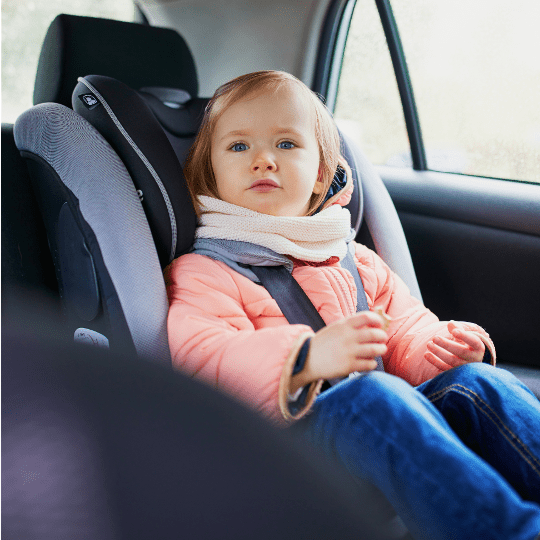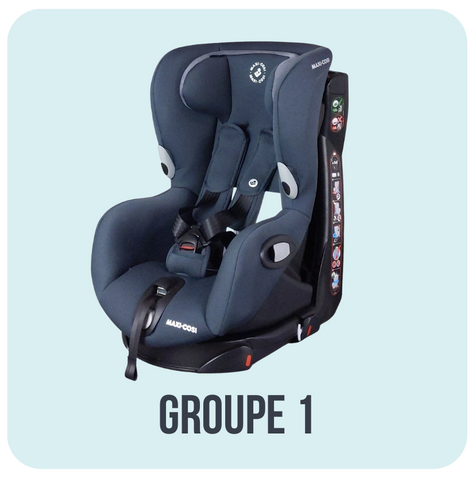
Which car seat should I choose based on my child’s age?
We can't talk about road safety without talking about car seats. Choosing this equipment, which appeared in the United States in 1930, is simple once you understand how the classification works. Depending on the age, weight and height of your child, the seat to use will be different.

What is a car seat used for?
At the very beginning, the interest for parents in using car seats was to transport their children with them, in complete peace of mind in their car. In the 1960s, with the modernization and improvement of cars and the increase in the possible speed of cars, it was more than logical to ask the question of child safety and to innovate in this direction.
The pioneer brand in this area is none other than Britax Römer with its Star Rider model, then in the 70s Peggy. Obviously, these seats were great feats for the time. Today, the shape and specificities of car seats have evolved significantly. Likewise, standards are evolving enormously in this area.
However, so that these standards followed (checked) by the seat can be used to properly protect your baby, you will need to take the time to secure him properly in your car. So don't be in a hurry and take your time during the installation.
Standards and obligations
“All children under the age of 10 must be secured in a restraint device adapted to their body type. Approval, certifying that these devices meet European Union standards, is mandatory.”
Source: securité-routiere.fr
Therefore, on the label attached to your car seat, it must be written:
- The letter “E” to specify that the seat complies with the European standard. This letter is followed by a number, referring to the country where the approval was issued (for example E 2 for France )
- And the reference “ R44 ”, standard based on the weight of the child, or “R129” (or “i-size” or “R129 i-size'”) , standard based on the height of the child. Note that the R44 standard will soon be completely replaced by R129 which will be the one and only valid ECE standard in force.
In short, any child up to at least 10 years old (or 1.35m) must be in a car seat with an approval visa. The installation in the front must remain exceptional, and only in the case where all the places in the rear seat are occupied by children under 10 years old.
Group 0 and 0+, Group 1, Group 2 and 3… Quèsaco?
These classes were created to make it easier to choose a car seat based on your baby's height (or weight) until he or she becomes big enough to occupy the standard car seat.
There are currently five device groups, but these 5 Groups are often grouped as follows for easier reading:
-
Group 0 and 0+ seats: shell/cozy seats

Car seats in these two groups are specifically designed for newborns. From birth up to 10 kg or 70 cm for Group 0, and from birth up to 13 kg or 80 cm for Group 0+.
The recommendations regarding these seats are, firstly, to install the seat rearward facing, for as long as possible, but at least until its 9 kg (6 months - 9 months). The benefit of having your back facing the road and that in the event of an accident, your baby's cervical vertebrae are less exposed. The second recommendation is to install your baby in the back. By installing it in the front and rear facing you will be forced to deactivate the airbag, deactivation not necessary if the car seat is placed facing the road.
To summarize, note that you will always need to start with a Group 0 or 0+ seat. If your car is large enough, you can opt directly for a 0+ seat rather than 0, because, thanks to its dimensions, it will protect your baby a little longer and therefore allow you to move to the higher category (Group 1) a bit later .
Well, it's either one or the other, there's no need to first use a Group 0 seat and then change it to a 0+ seat. Both can be used from birth, so make your choice in advance.
-
Group 1 seats: bucket seats

When your child begins to exceed 70-80 cm, or their weight approaches 13 kg, it is time to upgrade your car seat and move to Group 1. Now able to sit down and being a little less fragile, it can now travel facing the road. The seats in this category help protect your child's hips thanks to the raised sides of the seat and the always-present harnesses.
These seats can be used up to more or less 18 kg or 1 meter. To give you an idea, children aged 4-5 are on average a little over 1m tall.
-
Group 2 and 3 seats: seat with backrest or booster seats

From a minimum of 1m25 or 15 kg, the legislation would require your child to move to group 2 or 3 car seats. Knowing that for Group 2, the recommended weight is between 15 and 25 kg, while for Group 3, he is between 22 and 36 kg.
Knowing that the transition and the choice will always be made based on weight and size. And for example, if you have a 3 year old child, you will have to combine their height and weight to find their perfect seat. Indeed, the average height of a 3 year old child is 94 cm, which is equivalent to a Group 1 seat, however, if he weighs 20 kg he may need to move towards Group 2.
When it is time for your child to change car seat groups, you will inevitably see booster seats. Booster seats are simply car seats without a back, a seat that children like to use because they now feel more like a child, they are grown up now. But be careful, even if you want to please them, you must first think about their safety. And the presence of the backrest on the seat, the side protections, and the belt support provided by the car seats
with file are not unimportant. So always choose seats with backrests if your budget allows it.
You can watch this 8-second video produced by Cybex France , to see the difference between a car seat with a backrest and a booster seat and the impact during an impact.
Carrycot bed or car seat?
Quite practical, the carrycot bed (or carrycot) is a piece of equipment that clips onto the stroller, and allows your baby to stay in a lying position. A position that is strongly recommended to keep at birth and in the few months that follow. The case of the carrycot is debated because, despite the few advantages it offers, its use is not optimal for a car trip.
In fact, it already takes up more space in the car than a car seat because it must be placed horizontally. Which means that 2 seats in the back will already be taken by her. In addition, for the rare approved carrycots that can be used in a car, its use will be a little shorter than for seats in group 0/0+. Because your baby grows quickly and may no longer have enough room for his feet quickly enough. Finally, and most importantly, in terms of safety, the carrycot is not recommended. She does not have an adequate harness to protect the baby in the event of an impact. Namely, its use is even prohibited in certain European countries (Germany and northern countries), in Canada and in the United States.
Biicou can therefore only advise you to opt for a cozy one, rather than a carrycot for your car journeys!
Particularities
-
Adjustable seats:
Some evolving seats cover a wider range of the child's development period. Thus, you will be able to find the following groups in the same seat:
- Group 0/1: From birth to 18 kg (from birth to 6 years)
- Group 2/3: From 15 kg to 36 kg (from 4 years to 12 years)
- Group 1/2/3: From 9 kg to 36 kg (from 12 months to 12 years)
- Group 0/1/2/3: From 9 kg to 36 kg (from 12 months to 12 years)
-
Swivel seats:
The swivel seat is, for sure, an exceptional invention that drastically changes the parent's life. Indeed, thanks to these seats which rotate 90° or even 360°, you can install your baby more easily, since the front of the seat can be positioned directly facing the door, which avoids you having to twist in every way to install it.
You now have all the cards in hand to choose the perfect car seat for your baby. And since your new seat is likely to travel at one point or another from your car to grandpa's car, then from grandpa's car to your best friend's car, also take into consideration its weight and dimensions, in order to know if it is rather easy to transport and fit into any car.
You can find all our car seats by clicking here .

